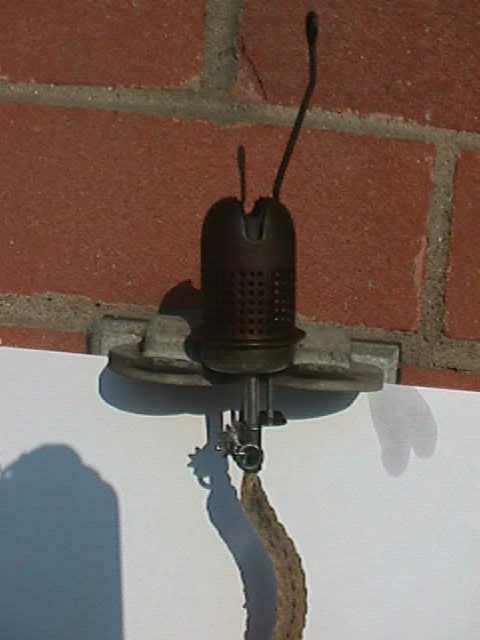Night Flash
is a hypothetical name given to this experimental version of the Night Watch. It is believed that only ten were made sometime around 1954. Five were retained by Dietz (and are now in private hands). Three went to Niagara Mohawk Power for evaluation. The disposition of the latter, as well as the remaining two, is unknown.
Other than the burner, this lantern differs from a standard Night Watch as follows:
Red over blue finish rather than the standard yellow
The only embossing found on the fount is "Pat. Pend." (faintly).
The globe fits "upside down"
This was to be the alternative to battery operated barricade flashers. It didn't happen


Note the wick raiser is at the bottom of the burner - INSIDE the font.
The vertical wire moves up and down to adjust the flash rate.
Frank Webb explains how the Australian flasher worked which is probably similiar to this burner:
"The flashing operation relies upon the build up and ignition of a
kerosene air mixture and the modification to the standard "dead flame"
burner was really very simple to achieve this mode of operation.
The gas and air mix in a chamber below the plate in which the wick tube
protrudes up through the flame spreader. The aperture for the wick
sprocket is where the air actually mixes with hot kerosene vapors and
passes up through either a hole or tube in the plate beside the wick
tube. Holes were punched in the chamber below the flame spreader to
allow air to mix, the more small holes the more rapid would be the
flashing.
The height of the wick tube below the flame spreader was critical as
well.
First Artcraft Flashing lamp
The first Artcraft lamp was of the British BS 3143 type design however
it was considerably taller than what was normal, of note, all Artcraft
lamps followed the basic BS 3143 requirements whereas Appleton and
Brandt had a range of unique designs.
The Fresnel lens were positioned high up in this model so that the lamp
was well below and not visible until the explosion of gas hence the
flash.
Second Artcraft model Blinking lamp
The second model whilst of the same BS 3143 type case was not as tall as
the first model so that the flame of the burner was always visible but
simply got a lot brighter when the gas ignited hence the name blinking.
The flash resulted in poor combustion of the kerosene and so there is a
much faster build up of carbon deposits in the top of these lamps than
normal, as such the top inner weather protecting vent on these Artcraft
lamps was removable to facilitate cleaning, on normal lamps these top
covers are spot welded and not intended to be removed."